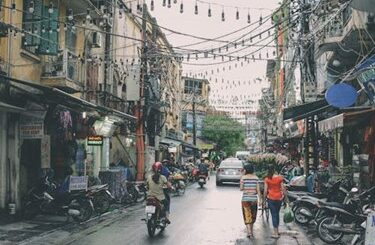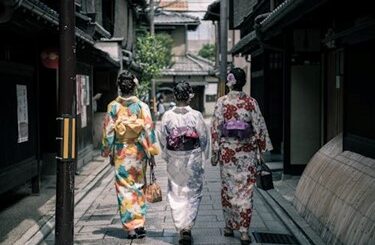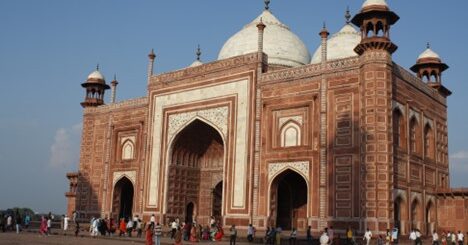Hue
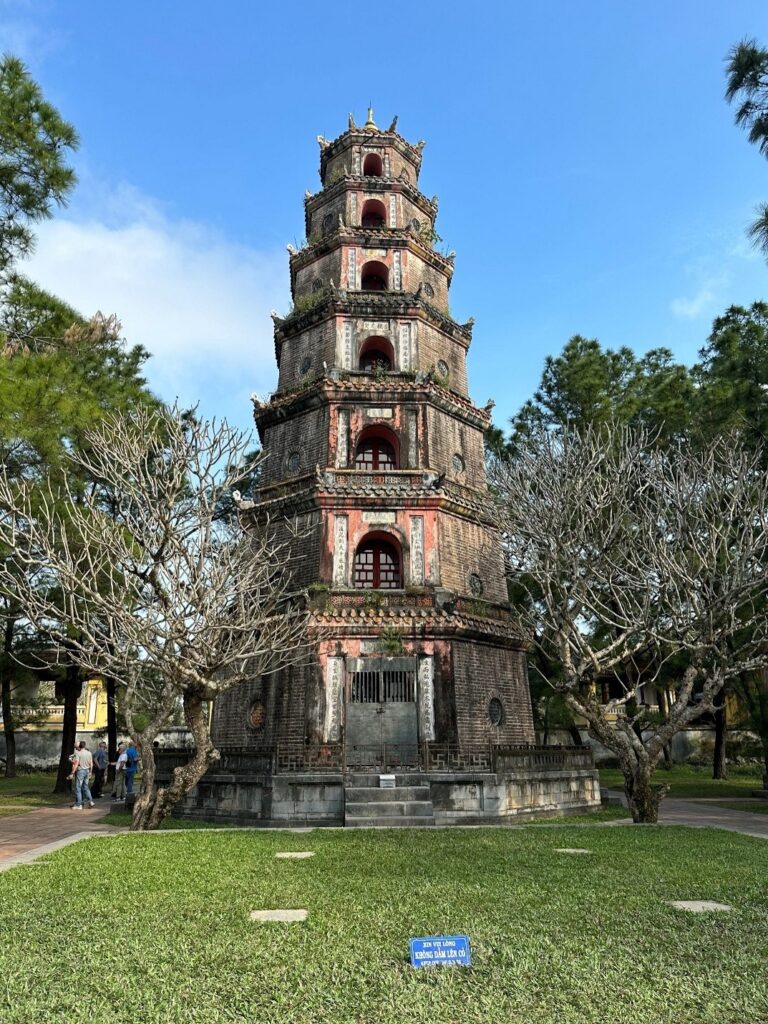
We drove from Hoi An to Hue, passing through the Hai Van Tunnel and making a stop at Da Nang along the way.
Hai Van Pass is a lovely stretch of coastal highway. Mountains on one side and Da Nang Bay on the other side. It also played a role during the Vietnam war, or what the Vietnamese call the “American War”. It was a strategic area representing a major barrier to any land army that tried to move between north and central regions of the country.
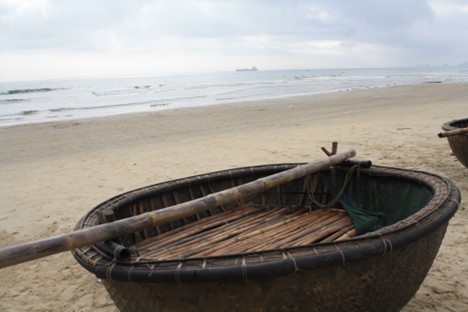
We made a stop in Da Nang at the My Khe Beach near the downtown area. This is a beautiful stretch of beach with pristine sand and clear blue waters. We arrived in time to see a few fisherman come back in their round kettle shaped “basket ”boats or hung chai. The fishermen go out to get their catch early in the morning or some we saw had gone out to a collection point where they were growing baby lobsters or other delicacies that they would then sell to a local buyer on the beach. I understand that you can get a ride in one of the boats, but we were content to see them in action, without going for a ride. Hello, Dramamine!
.We didn’t go into the city of Da Nang, but there is a lot of South Vietnamese/US history here. This area was a major air base area for United States and South Vietnamese operations during the war. The trip between Hoi An and Hue is about 3.5 hours plus stops.
We began our next day with a full day city tour of Hue, a UNESCO World Heritage Site. Hue is a very important historical city and a former major center of power in Vietnam. It was the seat of the Nguyen Dynasty emperors and the national capital from 1802 to 1945 when the country split into North and South Vietnam.
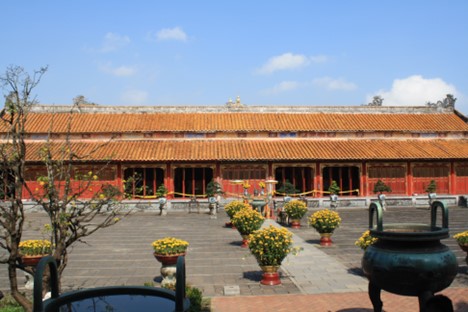
First up was a cyclo ride to the Imperial Citadel. A cyclo is a three-wheeled bike with a double seat and awning for the riders in the front and one man with very strong legs pumping the bike pedals in the back. We asked our guide if the cyclo drivers dreaded driving (sometimes overweight) tourists, but they politely answered, “Of course not!”. You can be the judge! Accessible entrance and parking, though walkways may be uneven.
The Imperial Citadel is Vietnam’s version of the Forbidden City in Beijing. It was originally a military stronghold and housed many palaces of the imperial family, as well as shrines, gardens, and villas for mandarins. Enter through the Meridien Gate and allow plenty of time to stroll around. Modeled on the Forbidden City, you can see the different levels of public areas leading to the forbidden areas of the palace, which were the royal living quarters. Don’t miss the nine large bronze Dynastic urns in the Hien Lam Pavilion, each representing a Nguyen Emperor. A bit of walking and stairs here.
Next up was the Long An Palace and the Museum of Royal Antiquities. The Museum houses a huge collection of artifacts from the time of the Nguyen Dynasty including ceramics, bronzes, and personal items from the emperors. The museum also lays out the history of the Nguyen Dynasty and the broader history of Vietnam. Allow at least an hour or more.
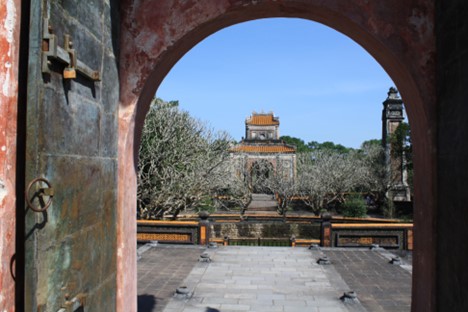
We then hopped on a traditional Vietnamese Dragon Boat to visit Thein Mu Pagoda. It was a pleasant, but short cruise on the Perfume River. The name of the Perfume River is said to originate from the flowers that grow in orchards upriver from the city of Hue. In Spring the petals fall into the river and create a distinctive pleasant smell. Not accessible.
Thein Mu Pagoda, meaning “Heavenly Lady”, is a historic seven-story Buddhist shrine and symbol of Hue. It was bult in 1601 by one of the first Nguyen dynasty lords and has been a historical organizing point for Buddhism in Vietnam. It is straight up the stairs from the boat landing point and the Pagoda seems to appear from out of nowhere as you make landing. It certainly makes an impression. We also enjoyed a exhibition of bonsai here as well as the many flowering plants in the pathways. It was a very pleasant stop.
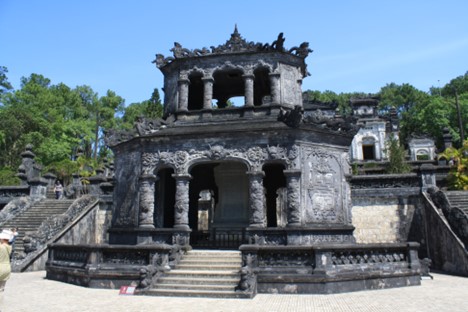
Our packed schedule continued after a quick lunch. We drove to the Royal Tombs of Khai Dinh and Tu Duc a definite “Must See” when visiting Hue. The Tomb of Khai Dinh, the twelfth Nguyen emperor, is one of the most ornate of Nguyen Dynasty royal tombs. Completed in 1931 the inside of the tomb is decorated with pieces of glass, porcelain and ceramic mosaics, it is awe inspiring especially when compared to the gray outside of the building. The architecture of the tomb is uniquely Vietnamese and there are several stone figures of animals and guards outside the tomb, meant to protect the grave and guide the deceased’s spirit to and from the tomb.
Nearby Tu Duc Mausoleum is one of the most graceful and well-preserved among the tombs of the Nguyen emperors.It is the tomb of the fourth Nguyen emperor. Again, Hue Vietnamese architecture that lies in harmony with the surrounding nature. Completed in 1867. A word on the tombs…there are several steps leading up to the tombs, so take your time. Also, we were traveling in early February, and it was pretty hot. Take a hat, sunscreen and plenty of water. Tu Duc is accessible, however, Khai Dinh is not.
After a long day of sightseeing, it was nice to walk over to a nearby park at the top of a mountain, featuring a incomparable view of the Perfume River. We bought a cold drink and some cakes from a vendor and had a seat to watch the boat traffic and the approaching sunset. It was a perfect ending to a perfect day.
Unfortunately, we only spent one busy day in Hue. It would’ve been nice to spend two, but we were next headed for Hanoi and then to Halong Bay.
Where we stayed: Eldora Hotel. Breakfast included. Nice hotel. Centrally located.Accessible parking, entrance, elevator and common areas.
How we got there: 3.5 hour drive from Hoi An to Hue. This was part of a four-week private tour through Vietnam, Cambodia, Laos and Thailand.
General Accessibility Information: See notes above. Vietnam has made strides in accessibility, though some challenges remain. many of the larger cities have accessible tours, sights, transport and hotels. Call in advance to verify and make specialty arrangements.See our sections on specialty apps and accessible travel for more on accessibility assistance.

